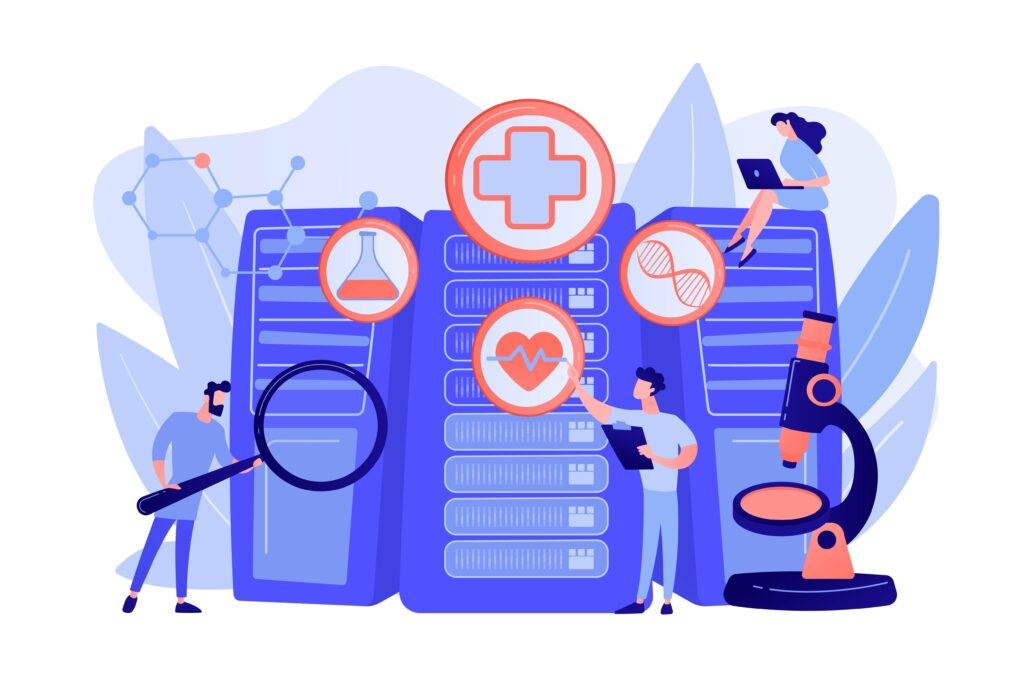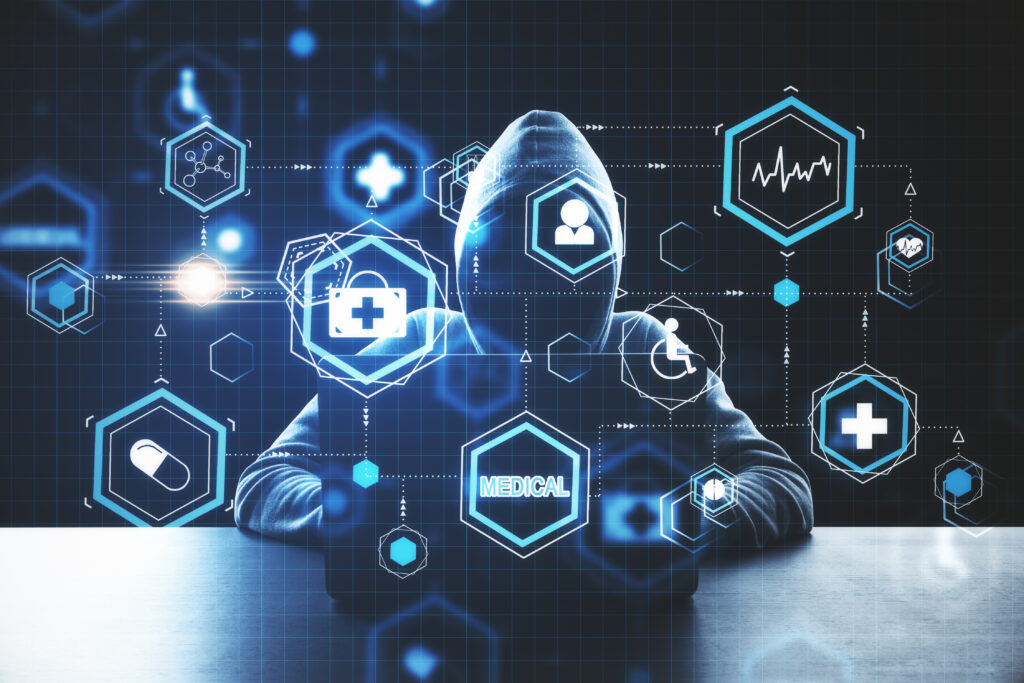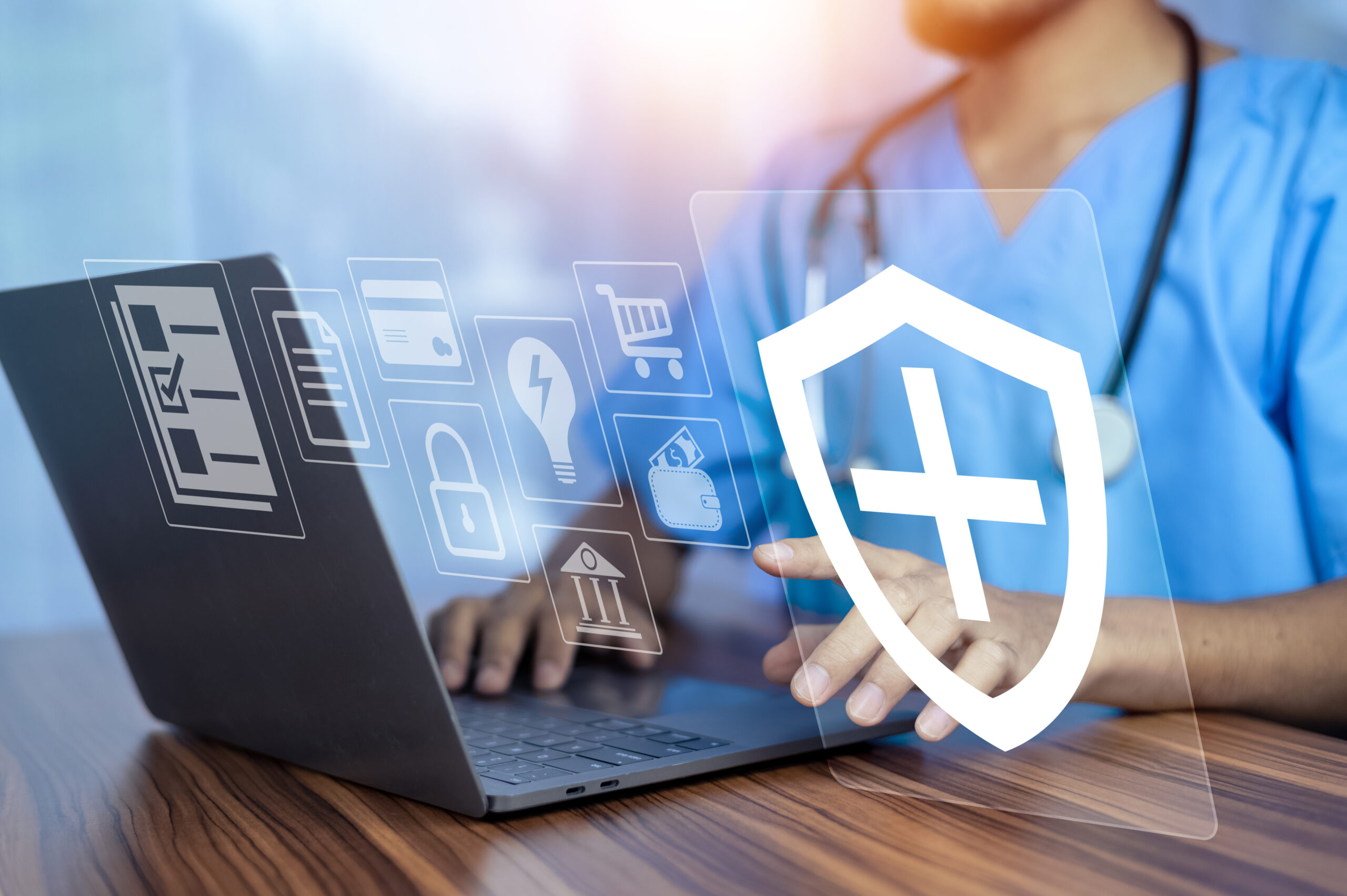Healthcare cyber security is crucial for protecting patient data and healthcare systems from cyber threats. This article examines common risks, effective defenses, and strategies to enhance security in healthcare.
Key Takeaways
– Healthcare cybersecurity is critical for protecting sensitive patient data and ensuring operational continuity, requiring a comprehensive and evolving strategy against diverse cyber threats.
– Major threats include ransomware, phishing attacks, insider threats, and vulnerabilities in connected medical devices, necessitating targeted prevention strategies and a culture of vigilance within healthcare organizations.
– Implementing best practices such as employee training, strong access controls, regular risk assessments, and advanced cybersecurity solutions like Zero Trust Architecture is essential for maintaining the integrity of healthcare systems.
Understanding Healthcare Cyber Security

Healthcare cybersecurity includes various practices and technologies with the primary goal to safeguard healthcare systems, patient data, and medical devices from cyberattacks. Its primary focus is on protecting sensitive data and critical systems from various risks. It includes protecting digital assets such as:
– Electronic health records
– Patient data
– Medical devices
– Other critical systems As healthcare systems become increasingly digital, the need for robust cybersecurity measures has never been more urgent.
The significance of healthcare cybersecurity extends beyond just data protection; it is crucial for maintaining the trust between patients and healthcare providers and ensuring uninterrupted healthcare services. Effective cybersecurity measures can profoundly impact patient outcomes, organizational reputation, and operational continuity. Network security, in particular, plays a vital role in defending against sophisticated cyber threats that can compromise patient data and disrupt healthcare delivery.
Looking ahead, healthcare cybersecurity strategies must evolve to address future shifts and prioritize comprehensive approaches beyond just perimeter security. Innovative technologies will play a crucial role in fortifying healthcare systems against rising threats.
Cultivating a culture of cybersecurity within healthcare organizations fosters a proactive environment where staff see themselves as defenders of patient data. This cultural shift is essential for creating a resilient healthcare cybersecurity framework that can adapt to the ever-changing threat landscape.
Major Cybersecurity Threats in Healthcare

Healthcare organizations are prime targets for cyberattacks due to the valuable information they possess, including personal health and financial data. Key points include:
– In 2024 alone, the healthcare sector faced the highest number of cyber threats among critical infrastructure sectors, with 444 reported incidents.
– The cost to resolve a cybersecurity breach in healthcare is significantly higher compared to other sectors, averaging $408 per affected record.
– These breaches are not just expensive; they also disrupt patient care, compromise data security, and erode trust in healthcare providers.
The major cybersecurity threats in healthcare include:
– Ransomware attacks
– Phishing attempts
– Insider threats
– Vulnerabilities in connected medical devices
– Cybersecurity issues
Each of these threats poses unique challenges and requires specific strategies to mitigate the associated risks. Understanding these threats allows healthcare organizations to implement targeted measures, enhancing their cybersecurity posture and protecting sensitive patient data.
Ransomware Attacks on Healthcare Systems
Ransomware attacks have become increasingly prevalent in the healthcare sector, with a significant 42% rise in incidents reported in 2022 compared to the previous year. In 2024, 181 ransomware attacks were confirmed in the healthcare industry. These attacks can severely disrupt healthcare delivery, as they often lead to the encryption of critical systems and patient data, rendering them inaccessible until a ransom is paid.
The financial impact of ransomware attacks on healthcare organizations is staggering. In 2024, 67% of healthcare organizations were affected by ransomware, with an average ransom payment of $900,000 following these attacks.
Beyond the financial costs, ransomware attacks jeopardize patient safety by delaying treatments and causing operational disruptions. Robust cybersecurity measures and continuous monitoring for potential threats are crucial to mitigating the risk of ransomware attacks in healthcare.
Phishing Attempts Targeting Healthcare Providers
Phishing attempts are a pervasive threat in healthcare settings, targeting healthcare providers to gain unauthorized access to sensitive information. These attacks often exploit human errors, deceiving employees into providing credentials or other sensitive information. The impact of successful phishing attempts can be severe, leading to unauthorized access to sensitive patient data and potentially compromising patient safety.
Recognizing and preventing phishing attempts is crucial for safeguarding patient data in healthcare environments. Training programs that enhance staff awareness and teach them to recognize phishing attempts are vital in mitigating this threat.
Fostering a culture of vigilance and incorporating robust email security measures can significantly reduce the risk of phishing attacks.
Insider Threats in Health Care Organizations
Insider threats pose a significant risk to healthcare organizations, with approximately 70% of healthcare breaches caused by internal actors. These threats are especially harmful due to insiders having trusted access to sensitive data. This access makes it more difficult to detect their actions. Unauthorized access to sensitive data by insiders can lead to significant breaches and erode patient trust.
Implementing robust identity protection measures helps prevent unauthorized access from both external and internal sources. Healthcare organizations need to monitor and secure their internal systems effectively to mitigate insider threats.
A non-blaming culture encourages transparency and helps address insider threats more effectively. Both malicious intent and human error contribute to insider threats in healthcare organizations, making comprehensive monitoring and security measures essential.
Vulnerabilities in Connected Medical Devices
Connected medical devices are essential for modern healthcare delivery, but the medical device also presents significant cybersecurity risks. Vulnerabilities in these devices serve as common entry points for hackers. The interconnectivity and reliance on outdated systems and off-the-shelf software further complicate their security management.
The security challenges posed by connected medical devices impact patient safety and data security. During crises, the interconnectivity and interoperability of medical devices can ensure patient safety by making them particularly vulnerable to cyber threats.
With the increased use of IoT devices in healthcare, especially during the COVID-19 pandemic, the cybersecurity risks associated with connected medical devices have become more pronounced. Addressing these vulnerabilities is crucial to ensure the safety of patients and the integrity of healthcare systems.
Impact of Data Breaches on Patient Outcomes

Data breaches in healthcare have far-reaching consequences that extend beyond financial losses. They are associated with increased mortality rates in critical conditions, such as heart attacks. When patient data is compromised, it can lead to incorrect treatments and increased risk of adverse outcomes, directly impacting patient safety. The operational disruptions caused by data breaches, including care delays and facility shutdowns, further exacerbate the negative impact on patient outcomes and clinical outcomes.
From 2005 to 2019, healthcare data breaches resulted in the loss of patient records affecting over 249 million individuals. These breaches severely impact patient privacy, potentially exposing sensitive information and leading to substantial penalties under privacy regulations.
Internal actors are responsible for a significant portion of these breaches, highlighting the need for robust security measures within healthcare organizations to protect patient data and maintain trust.
Best Practices for Enhancing Healthcare Cyber Security

Implementing best practices for healthcare cybersecurity best practices is essential for protecting sensitive patient data and maintaining the integrity of healthcare systems. Healthcare organizations should utilize a combination of technical and procedural risk mitigation strategies to bolster their cybersecurity posture. This includes adopting multifactor authentication, robust remote access monitoring, and continuous staff training to reduce vulnerability to cyber threats.
Partnering with cybersecurity experts provides valuable training for staff, enhancing the overall security culture within healthcare organizations. During the COVID-19 pandemic, some healthcare providers increased their investment in cybersecurity training programs to enhance staff awareness and reduce vulnerability to phishing attacks.
Tools like NHS Digital’s self-assessment toolkit help healthcare organizations evaluate their data security and protection practices, promoting better cybersecurity hygiene. These partnerships also enable healthcare providers to benefit from ongoing security assessments and tailored risk management programs.
Employee Training Programs
Ongoing training programs are crucial for enhancing staff awareness of cyber threats beyond initial education. Key points include:
– Phishing attacks exploit vulnerabilities in healthcare by targeting human factors to trick employees into revealing credentials.
– Fostering a non-blaming culture encourages the reporting of insider threats.
– Encouraging reporting helps in addressing these issues more effectively.
Strong Access Controls and Data Encryption
Key measures for protecting sensitive patient data include:
– Data encryption, which plays a crucial role in protecting data from unauthorized access.
– Encryption providing an additional layer of protection against data breaches and cyberattacks.
– Strong access controls to ensure that only authorized personnel have access to sensitive healthcare data.
Multi-factor authentication (MFA) and network access control (NAC) enhance security by managing access and requiring multiple forms of validation.
Regular Risk Assessments and Updates
Regular risk assessments are essential in healthcare cybersecurity to identify security risks, as a sector risk management agency would emphasize. These assessments allow organizations to prioritize remediation efforts effectively.
Regular evaluations of security controls are vital for adapting to evolving cybersecurity threats.
Advanced Cybersecurity Solutions for Healthcare

Advanced cybersecurity solutions are paramount for protecting sensitive patient data and maintaining healthcare system integrity. Collaborating with cybersecurity specialists can provide healthcare organizations with access to the latest defense technologies and strategies. Partnerships with cybersecurity firms can significantly reduce the time needed to detect and respond to cyber threats.
Various cybersecurity solutions have been identified across the public health sector and health and human services, each tailored to address specific challenges and improve cybersecurity. The department of health has established a cybersecurity working group to further enhance these efforts.
Endpoint Detection and Response (EDR)
Endpoint Detection and Response (EDR) tools provide:
– Continuous monitoring of endpoints to detect and respond to security incidents swiftly.
– The ability to isolate infected devices to prevent the spread of malware within healthcare networks.
– Data collection from endpoints to identify and respond to potential security threats effectively.
The integrated response mechanisms of EDR tools enable healthcare organizations to mitigate damage from threats efficiently.
Zero Trust Architecture in Health Care
Zero Trust Architecture operates on the assumption that threats can originate both outside and inside the network. This architecture emphasizes that no user or device should be trusted by default, regardless of their location.
Continuous verification of user identities and device security within Zero Trust Architecture minimizes risks and enhances the overall security posture of healthcare organizations.
Secure Remote Access for Telehealth Services
Securing remote access is crucial for telehealth services, which have become increasingly popular. Securing remote access involves implementing virtual private networks, multi-factor authentication (MFA), and network access controls.
The NHS has adopted constant monitoring of its remote access infrastructure to enhance cybersecurity measures. Healthcare staff utilize enterprise remote desktop protocols and VPNs for secure remote access, ensuring patient safety and data security.
Developing an Incident Response Plan
A comprehensive incident response plan is a strategic priority for healthcare organizations. This plan should be integrated into existing governance, risk management, and operational continuity frameworks to ensure preparedness for cyber incidents. Healthcare institutions are increasingly implementing incident reporting protocols to improve their response to cyberattacks and enhance overall security posture.
A comprehensive assessment is necessary to ensure clinical and operational continuity for at least 30 days during a cybersecurity incident. Utilizing a Coordinated Healthcare Incident Response Plan (CHIRP) can enhance the effectiveness of cyber incident responses.
Regularly updated guidelines, such as the #StopRansomware guide, provide critical information for responding to ransomware threats specifically in healthcare.
Collaborating with Cybersecurity Experts
Partnering with cybersecurity firms provides healthcare organizations with several benefits:
– Access to specialized expertise and advanced security solutions.
– Assistance in staying compliant with industry regulations and standards.
– Strengthening healthcare systems against evolving cyber threats.
Such partnerships not only improve security posture but also build trust with patients by ensuring the protection of their health information sharing data.
Case Study: Successful Cyber Security Implementation
Owensboro Health serves as a prime example of how effective cybersecurity implementation can transform healthcare organizations. Expanding their cyber risk management strategy through Clearwater’s ClearConfidence™ program allowed Owensboro Health to achieve a continuous and comprehensive approach to managing cyber risks. This initiative not only enhanced their cybersecurity posture but also ensured the protection of sensitive patient data and critical systems.
Similarly, CaringWays developed a cloud-based security program in partnership with Clearwater, significantly enhancing their cybersecurity and HIPAA compliance efforts.
Another notable example is Brno University Hospital, which bolstered its defenses following a significant ransomware attack that disrupted its operations. These successful implementations highlight the importance of robust cybersecurity measures in protecting patient data and ensuring the privacy and security of health systems, healthcare systems, and healthcare facilities.
Summary
In summary, healthcare cybersecurity is a critical component of modern healthcare systems, essential for protecting sensitive patient data and ensuring patient safety. Understanding the various cyber threats, such as ransomware attacks, phishing attempts, insider threats, and vulnerabilities in connected medical devices, is crucial for healthcare organizations. Implementing best practices, including employee training programs, strong access controls, and regular risk assessments, can significantly enhance cybersecurity posture and mitigate risks.
Advanced cybersecurity solutions, such as Endpoint Detection and Response (EDR), Zero Trust Architecture, and secure remote access for telehealth services, provide robust defenses against evolving threats. Developing a comprehensive incident response plan and collaborating with cybersecurity experts are also vital steps in strengthening healthcare cybersecurity. By learning from successful case studies, healthcare organizations can adopt effective strategies to protect patient data and ensure operational continuity. Remember, proactive cybersecurity measures are not just about compliance but about safeguarding the very essence of patient care.

Leave a Reply